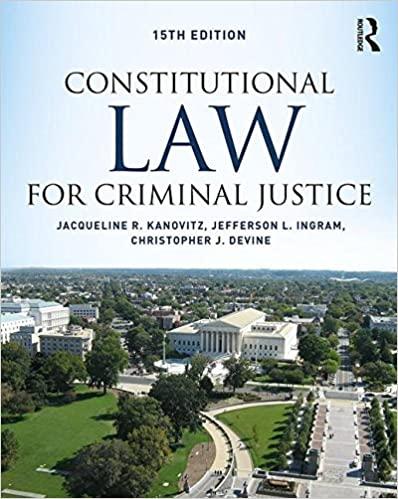Question
Chapter 1: Introduction to Law and Legal Reasoning. Primary sources of law (Constitutions, treaties, statutes, administrative law, and common law). Supremacy Clause of U.S. Constitution.
Chapter 1: Introduction to Law and Legal Reasoning.
Primary sources of law (Constitutions, treaties, statutes, administrative law, and common law).
Supremacy Clause of U.S. Constitution.
Distinction between courts of equity and courts of law (different terms for parties and proceedings,
no jury in equitable cases, equitable maxims apply only in equitable cases, money is the only
remedy in civil case in a court of law).
Jury trials only in courts of law (money or criminal cases).
Equitable maxims such as doctrine of unclean hands, laches, view substance over form, etc.
Chapter 2: Business and the Constitution.
Reasons for failure of government under Articles of Confederation after Revolutionary War.
Enumerated (delegated) powers given to Congress by states in current U.S. Constitution.
The Commerce Clause in Article 1.
Expansion of concept of interstate commerce from goods crossing state lines to any activity which
"might affect the national economy." (The "wheat case.")
Preemption of regulation of certain fields by federal government, such as aviation, broadcasting,
bankruptcy, patents, copyrights, medical devises, immigration, etc.
Inherent "police power" of the states to regulate health and safety.
Conflict between state's police power and federal government's regulation of interstate commerce.
If no preemption by federal government: Balance benefit to safety against burden on interstate
commerce. If federal preemption (such as aviation) state cannot regulate; no balancing test.
Chapter 3: Ethics in Business. No material will be tested.
Chapter 4: Courts and Alternative Dispute Resolution.
Concept of judicial review, Marbury vs. Madison: any court, when asked to enforce a law, has the
right and duty to review the law to determine if it is constitutional.
Jurisdiction of courts based on geography (in personam jurisdiction over persons in a state or those
doing business in a state; in rem jurisdiction over a "thing" within a state such as real property).
When only in rem jurisdiction exists, court is limited to dealing with the "thing."
General jurisdiction of state courts. Inherent police power which pre-dates U.S. Constitution.
Limited jurisdiction of federal courts (federal issue or diversity of citizenship).
State courts: exclusive jurisdiction over divorce, paternity, probate, state crimes, state taxes.
Federal courts: exclusive jurisdiction over federal crimes, bankruptcy, aviation, broadcasting,
federal taxes, immigration, medical devices, postal matters, currency, and Social Security.
State courts and federal courts: Concurrent jurisdiction over diversity of citizenship cases and civil
rights violations, age discrimination cases, disability access cases, pension and medical insurance.
Difference between arbitration and mediation.
Advantages and disadvantages of arbitration and mediation compared to court cases.
Chapter 5: Court Procedures.
Burdens of proof in criminal cases compared to civil cases.
Percentage of jurors required to reach verdict in criminal and civil cases (different rules).
Chapter 6: Tort Law.
Purpose of tort law in general (compensation of injured person).
Differences/distinctions between torts and crimes, especially in court procedures.
Assault and battery: elements of each tort; defenses.
Intentional infliction of emotional distress: elements, be prepared to recognize example.
Defamation: elements and defenses, including privileges. New York Times vs. Sullivan.
Elements of negligence (duty of care, breach, causation, and injury).
Reasonable person standard. Special duty of care for landowners.
Local standard for determining standard (duty) of care for professionals.
Proximate cause and unforeseeable plaintiffs: Palsgraf vs. Long Island Railroad.
Defenses to negligence (assumption of risk, contributory negligence, and comparative negligence.).
Res ipsa loquitur. (Elevator falling, wrong leg amputated, etc.)
Negligence per se. (Violation of a safety statute designed to prevent the harm which occurred..)
Chapter 7: Strict Liability and Product Liability.
Abnormally dangerous activities:
Large man-made bodies of water, explosives, wild animals, domestic animals with known
dangerous propensities.
Liability without fault, regardless of being careful for those involved in abnormally dangerous
activities. Situations where both negligence and strict liability occur at same time.
Chapter 8: Intellectual Property Rights.
Purpose of trademarks. Examples of trademarks. Expiration date?
Purpose of patents.
Purpose of copyrights. Fair use exception.
Consequences of infringement on intellectual property (destruction, criminal penalties, money
damages, possibly tripled, injunction against further infringement).
Chapter 9: Internet Law, Social Media, and Privacy. No material will be tested.
Chapter 10: Criminal Law.
Distinction between felony, misdemeanor, and infraction. (Potential, not actual punishment.)
Collateral consequences of conviction of felony and some misdemeanors.
Mean s rea and actus reus occurring at same time for defendant to be guilty (most crimes).
Step by Step Solution
There are 3 Steps involved in it
Step: 1

Get Instant Access to Expert-Tailored Solutions
See step-by-step solutions with expert insights and AI powered tools for academic success
Step: 2

Step: 3

Ace Your Homework with AI
Get the answers you need in no time with our AI-driven, step-by-step assistance
Get Started


